#Moravian Serbia
Text
LAZAREVIC SISTERS III
Princess Jelena Lazarevic
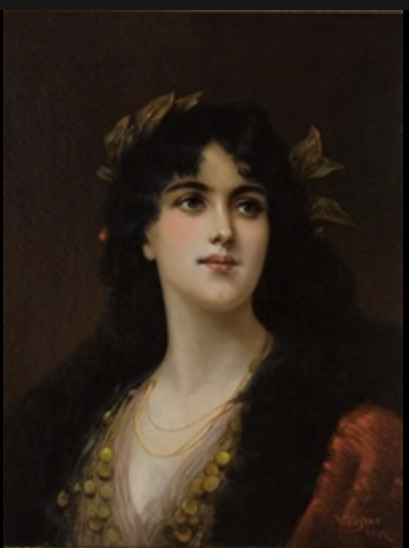
Early Life
Often referred to as “Jela” or “Lady Lena,” Jelena Lazarevic is renowned as a determined, beautiful, and courageous woman. She was born as the third in line of the royal daughters of Prince Lazar. It is noted that she was about 39 years old in 1403, this determines that she was born around 1364-1365.
Jelena was most than likely born in Prilepac and raised there for some time before moving to Krusevac where she continued her strict education under the guide of her mother; Milica and aunt; Jefimija.
As for the rest of her early life, nothing is known other than plausible education and living situation. The first information we have of her is in her early twenties when she married Durad II Balsic.
First Marriage
Around 1386 or 1387, Durad; Lord of Zeta, recognized Lazar’s as his ruler and lord and so to officialize his authority over the state of Zeta Lazar married his eldest unmarried daughter to him.
The couple had a single child together, Durad’s father namesaker and future successor; Balsa Balsic also known as ‘Balsa III’.
The purpose of this marriage remain political and sole purpose was to create an alliance as well as heirs. There are no mention of a possible love marriage between the two of them. Though it is noted that Durad often entrusted his wife to manage state affairs.
In early 1392, in fear of the uprising Turks, Durad sent word for his wife arrival in Dubrovnik in order to protect her and his heir, and though the government of Dubrovnik were aquiring the necessities for Jelena, she never arrived.
In September of that same year there was talk about her upcoming arrival, but she never came, yet again.
It was not until November of 1396 that Jelena would reach out to the Dubrovnik authorities for a ship to escort her to a meeting with Sandalj Hranić (who will later on become her second husband) as he had been fighting against the Balsic family for some time at that point.
This meeting might be one of tasks given to her by her husband. Jelena was noted to have a significant influence on the man.
As Regent of Zeta
In 1403, her late husband; Durad, passed away, and of course; the wise Jelena wasted no time and made her appearance as a subtitute ruler in full light. Due to her son’s inexperience and age, Jelena acted as his regent.
Many of the territories that belonged to Zeta were under Venitian rule and Jelena decided to reclaim said territories.
For five years she fought the Venitians to defend Zeta and her son’s inheritance despite facing harsh-trials. Through the uprising threats and council of disagreements, she followed as suited the interest of Zeta and her son.
In the reports of Jelka Redep in her book: КЋЕРИ КНЕЗА ЛАЗАРА ИСТОРИЈСКА СТУДИЈА ПОГОВОР…
“Jelena’s idea of rebellion was not just an empty desire. In the first days of 1405, a rebellion was planned in Zeta. Skadar revolted against Venitian rule, and the Prince barely escaped with his life. Durazzo also rose up in arms and recognized Jelena’s son as their ruler.”
In the early birth of this rebellion Jelena reached out to her younger brother; Despot Stefan Lazarevic, for aid, but due to his close-knit relationship with the Venitians he was unable to help her. Yet, she continued in her conquest with a temporary help from the Turks.
[Her own brother, the despot Stefan, was friends with both the Venetians and the Hungarians. Only the Turks agreed to help her, but even they only for a short time. Jela did not agree to her brother's proposals to reconcile with Venice, but persistently continued to fight, until 1406, when she had to agree to negotiations that lasted more than three years.
Miodrag Purković spares no words when he talks about how energetically and uncompromisingly Jela, as a widow, fought for the freedom of her country and her son's inheritance. She always took all the "blame" on herself instead of her son. In order to protect him, at the end of 1409, she went alone to negotiations in Venice, where she was kept for three months.
Purković points out how brave Jela was during those negotiations, and especially points to the fact that she was "neither confused nor afraid", unlike her mother, who once found herself in a similar situation before Bayazit in 1398. } - Dve srpske sultanije : Olivera Lazarevic (1373-1444) : Mara Brankovic (1418-1487) by Nikola Giljen, pg 169
Yet, despite this “Peace” Balsa continued his fight against the Venitians, but this only cost him great loss in territory.
Second Marriage
Prior to this marriage Duke of Bosnia; Sandalj Hranić (remember him?), who used to be married to a kin of Hrovoje Vukcic separated from his wife after this one's family lost influence in their political position.
Wishing to be associated with someone of more influence, Sandalj would later step a foot further and annulled his marriage to his wife; Katerina, since they shared no children, and instead offered for Princess Jelena Lazarevic or as she was known at the time Jelena Balsic; who at the time was the sister of a great ally of Sigismund.
This marriage, which was Sandalj's third marriage, benefited all parties involved, as Sandalj regained his position, Jelena now had one less enemy to worry about, and lastly Stefan was able to tie his new brother-in-law to him politically.
Strangely enough, this marriage could be considered a content union between the two. Sandalj is said to have been enchanted by his new bride/former enemy and to hold his step-son to high status and protect him at times.
Jelena is credited for this as she was known to have a powerful influence on this husband of hers who some would describe as an ‘arrogant man’.
Later Life
In April of 1421, the exhausted Balsa met with his uncle in Belgrade and transfered the remaining of his lands under this one’s protection. He soon passed away that same year. It is unkown how Jelena reacted to the news.
In 1423, she was visited by her youngest sister; Olivera, though this one might have been there more for diplomatic reasons to get news on her brother-in-law than for the sake of meeting her sister after 30 plus years apart.
Not much information has been recorded about Jelena’s where abouts until 1425. That year, the threat of the upcoming Turks were increasing and so as a result of this situation, Sandalj moved his family, including his wife, to Dubrovnik for protection.
After her husband death in 1435, she retired from state affairs as the state passed down to her late husband’s nephew, and she obviously could not have any influence on him.
She must have retired to her husband’s court in Novi, where it is assumed she lived an aristocratic lifestyle up and until her death.
Jelena passed away in 1443, living a good amount of her properties to her granddaughter and namesaker; Jelena. She left 200 ducats and a gilded icon to her only living sibling; Olivera, to be spent on a memorial for her as well as distribution to the poor.
Issue
Balsa III Balsic
( Sources: “КЋЕРИ КНЕЗА ЛАЗАРА ИСТОРИЈСКА СТУДИЈА ПОГОВОР” by Jelka Redep, Dve srpske sultanije : Olivera Lazarevic (1373-1444) : Mara Brankovic (1418-1487) by Nikola Giljen)
#Lazarevic Dynasty#Lazarevic#14th century#15th century#arranged marriage#Serbia#Moravian Serbia#History#geology#Lazar of Serbia#Lazar#Milica of Serbia#Đurađ II Balšić#serbian history#histoire#Jelena Lazarevic#Jelena Balsic#Stefan Lazarevic#jelenalazarevic#lazarevicsisters
46 notes
·
View notes
Text
Jajko🔥🔥 barzdo duze jajko🔥


#countryhumans#moravian serbia countryhumans#serbia countryhumans#cityhumans#cityhumans Kruševac#<- they're the same person to me
12 notes
·
View notes
Text
Europa Nostra - Most Endangered in 2023
On the occasion of the 10th anniversary of the 7 Most Endangered Programme in 2023, Europa Nostra – the European Voice of Civil Society Committed to Cultural and Natural Heritage – and the European Investment Bank Institute have just announced the 11 most threatened heritage sites in Europe shortlisted for this year’s edition of the programme.

Among 11 most endangered monuments and heritage sites in Europe for 2023 are Kortrijk Railway Station (Belgium), Domain and Royal Museum of Mariemont in Moralwez (Belgium), Tchakcinij Fortress in Zugdidi (Georgia), Sister's House Ensemble - former Moravian settlement in Kleinwelka (Germany), Mansion Konaki of Gidas in Alexandria (Greece), Herman Otto Museum in Miskolc (Hungary), Memento Park in Budapest (Hungary), Cultural Landscape of Paštrovska Gora (Montenegro), Cultural Landscape of Sveti Štefan in Paštroviči (Montenegro), Watermills of Bistrica in Petrovac na Mlavi (Serbia), and the Partisan Memorial Cemetery in Mostar (Bosnia and Herzegovina) designed by Bogdan Bogdanović.

A view from the top of the cemetery before the latest conflicts.
The selection was made on the basis of the outstanding heritage significance and cultural value of each of the sites as well as on the basis of the serious danger that they are facing today. The level of engagement of local communities and the commitment of public and private stakeholders to saving these sites were considered as crucial added values. Another selection criterion was the potential of these sites to act as a catalyst for sustainable development and as a tool for promoting peace and dialogue within their localities and wider regions.

A view on the central fountain at the top of the site.

A sketch showing the path of the water flow.
The 11 endangered heritage sites were shortlisted by an international Advisory Panel, comprising experts in history, archaeology, architecture, conservation, project analysis and finance. Nominations for the 7 Most Endangered Programme 2023 were submitted by member organisations, associate organisations or individual members of Europa Nostra from all over Europe as well as by members of the European Heritage Alliance. For the Partisan Monument in Mostar a support was given among others also by Architectuul and DESSA Gallery from Ljubljana.
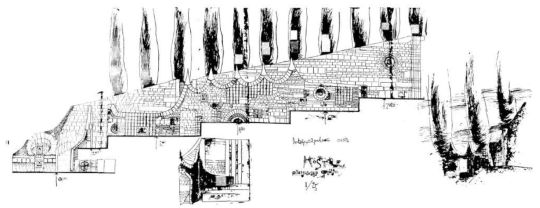
A cross-section of the cemetery and its terraces.
The Partisan Memorial Cemetery was built in 1965 in the town of Mostar. It is one of the largest anti-fascist monuments and sites in the Balkans, with its 300-metre-long paved ceremonial pathway rising more than 20 metres up a hill. The cemetery, which features some 700 individual tombstones as grave markers of freedom fighters from the Yugoslav Partisan movement, is part of a series of monuments and sites built in the region in memory of the partisans who died during World War II.
It was designed by the famous Yugoslav architect Professor Bogdan Bogdanović from Belgrade. Skilled stonemasons built the monument over several years, using over 12,000 carved limestone pieces, rubble from the town’s destruction during the war, and traditional stone roof tiles recycled from Mostar houses. The monument was inaugurated in 1965 by the President of Yugoslavia, Josip Broz Tito, on the occasion of the 20th anniversary of the liberation of Mostar from the Nazis and their local allies in 1945.
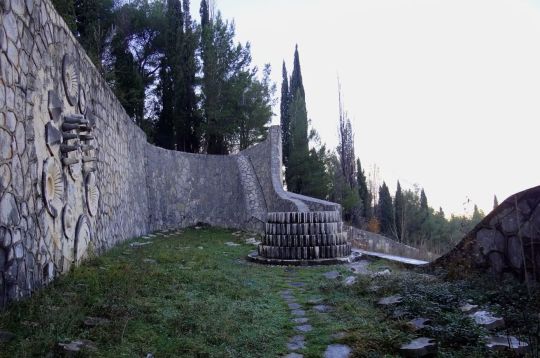
In front of the portal lies an a-centrically located gear-shaped fountain which used to develop a water stream that flowed down the terraces and emerged again in the dead end space at the bottom of the complex.
The Partisan Memorial Cemetery – with its memorial significance and relevance – has become a target for destruction, both in times of war and in times of peace. Although much damaged during the war in 1992-1995, the Partisan Memorial Cemetery suffered further damage in the period following the war. It is important to add that after the violent disintegration of Yugoslavia, many memorial sites built after World War II were neglected or even abandoned in the wider region, including the Partisan Memorial Cemetery in Mostar.
After the war, the first conservation and restoration works on the Partisan Memorial Cemetery were done in 2005 with the support of donor funds from the Government of The Netherlands and the Kingdom of Norway, and with co-financing from the City of Mostar and Federation of Bosnia and Herzegovina.
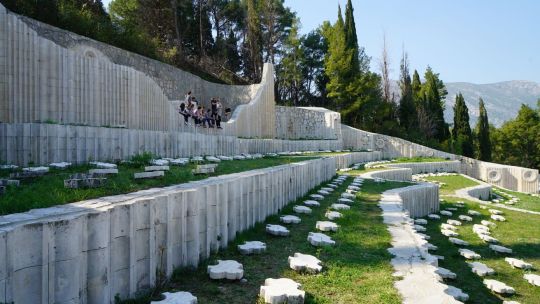
The complex is a necropolis, 630 abstractly shaped stone markers testify the multiethnic army that fought together and is buried here with names belonging to Serbs, Croats, Bosniaks, Jews.
However, the Partisan Memorial Cemetery has been, and still is, one of the region’s contested heritage sites. This has resulted in repeated acts of vandalism up until the most recent destruction which happened in June of 2022. This was followed by numerous reactions from the Mayor, the City Council, the Commission to preserve national monuments of Bosnia and Herzegovina, as well as from anti-fascist activists and associations both at local and international level, and also the reaction from numerous organisations from the territory of former Yugoslavia, which condemned the vandalism of the Partisan Memorial Cemetery. Recently, the Agency “Old City” of the City of Mostar launched the public procurement for the revitalisation, rehabilitation and illumination of the Partisan Memorial Cemetery. However, the monument does not yet have a holistic plan for its conservation and maintenance with a corresponding funding. The whole process of its necessary restoration and revitalisation therefore remains precarious.
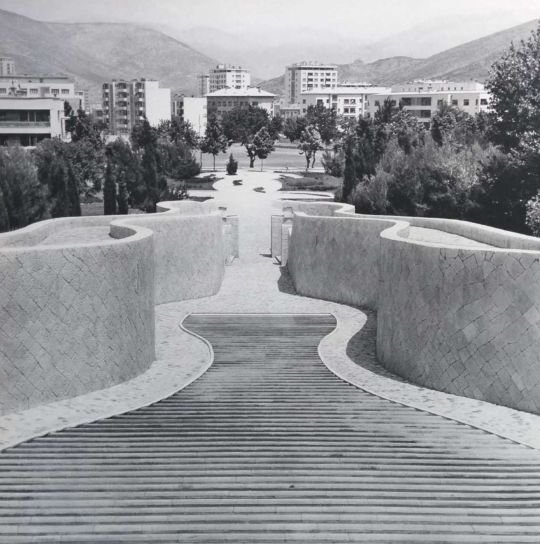
The partisan cemetery in Mostar is an integral part of the city and can be easily considered as an urban place.
The local community in Mostar has developed various campaigns for the legal protection of the Partisan Memorial Cemetery as a Monument of National Importance. Among other initiatives, they produced a documentary about the history of this memorial site and the threats and challenges it faces today.
The nomination of the cemetery to the 7 Most Endangered Programme 2023 was made by IDEAA Mostar with the endorsement of the Mayor of Mostar, the Galerija DESSA, Arcihtectuul and Europa Nostra Serbia. The nominator advocates for adequate legal protection of the Partisan Memorial Cemetery following its designation as a Monument of National Importance back in January 2006, for the European and international recognition of its outstanding historical and artistic values, as well as for the development of a sustainable rehabilitation, maintenance and management plan for this exceptional memorial site and the allocation of necessary funds – from local, national and European sources – for the quality implementation of such a comprehensive plan.
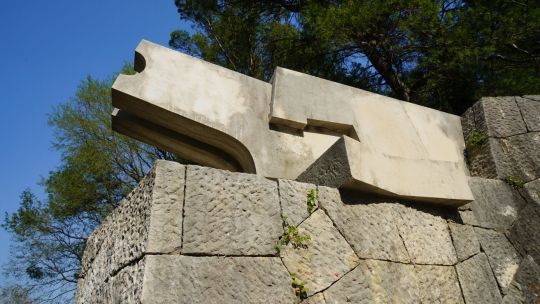
An abstract lion sculpture at the entrance of the complex.
The Advisory Panel of the 7 Most Endangered Programme commented: “The original design of the Partisan Memorial Cemetery in Mostar deliberately avoids the use of political or religious symbolism but makes use of cosmological symbols reminiscent of pre-Columbian remains and perhaps also referencing similar elements present in medieval sites in Bosnia and Herzegovina. As such, it is an outstanding example of the high-quality commemorative culture rooted in anti-fascist ideals within SFR Yugoslavia. At the time when Europe seeks to assert and put a much stronger emphasis on the vital importance of the shared values which form the very basis of the entire European project, this significant place of memory located in the Western Balkans should be restored with the support of local, national and European funds and protected for present and future generations.”

On Wednesday, June 15, 2022, vandals carefully and cold-bloodedly destroyed all the commemorative plaques.
The Executive President of Europa Nostra, Prof. Dr. Hermann Parzinger, stated: “This shortlist covers a wide variety of monuments and heritage sites which are facing different types of serious threats. The local communities and civil society organisations are deeply committed to preserving these remarkable examples of our shared heritage, but they need broader support. We therefore call on local, regional, national and European stakeholders, both public and private, to join forces with Europa Nostra and our network of members and partners to secure a viable future for these shortlisted sites.”

The "cosmic portal" is centrally located on the wall that backs the uppermost terrace. This circular element seems to act as a door between the two worlds and tries to reconcile the different visions that various religions have developed about the afterlife.
The final list of 7 Most Endangered heritage sites in Europe for 2023 will be unveiled in April.
21 notes
·
View notes
Text

In the neon-drenched alleyways of Moravian Serbia, a new era had dawned, one where the fusion of flesh and machine was more than just a possibility—it was the epitome of evolution. At the forefront of this revolution was Vasilije, a young engineer whose own body was a canvas of technological artistry.
Vasilije was once a mere human, a prodigy in the field of cybernetics, working in the underbelly of Belgrade, now a sprawling metropolis that stretched deep into the heart of the old Moravian lands. The city had become a haven for tech runners, hackers, and those who sought to push the boundaries of humanity. Vasilije had a vision, one that would blend the ancient resilience of the Serbian spirit with the unyielding power of cybernetics.
He had volunteered for the procedure, becoming his own test subject. The result was a masterpiece of human ingenuity, a seamless integration of alloy and skin. His right eye was now an intricate web of sensors, capable of infrared, UV, and electromagnetic field detection. The mechanical arm that replaced his flesh was a marvel, capable of immense strength and precision, its design inspired by the medieval armor housed in the forgotten museums of Moravia.
In his heart, however, Vasilije carried the old stories of Moravia, tales of resistance, of battles against empires that sought to crush the spirit of his people. He saw the rise of the machine as a new battle, one not against invaders but against the limitations of human biology.
The night sky was pierced by the towering spires of cyber-hubs, data streaming through the air like the northern winds once roamed free across the plains. Vasilije's enhanced senses could perceive the data flows, could almost touch the streams of information as they swirled around him.
His mission was clear: to protect the essence of humanity in this surge of technological advancement. There were entities, corporations that wanted to exploit cybernetics, to control and commodify human evolution. Vasilije stood against them, a one-man army, armed with intellect and enhanced capabilities, a guardian of the human soul.
As he walked through the streets of Moravian Serbia, the people looked at him with a mix of fear and admiration. He was the future, a living symbol of what they might become, a blend of past and future.
The story of Vasilije spread through the digital undercurrents of society, a tale of a man who was more than a man, a symbol of a new Moravia, standing resilient amidst the tides of time. The cyborg of Moravian Serbia became a legend, not only in the physical world but in the vast expanse of cyberspace, where he fought his battles, not with swords or guns, but with codes and an unwavering will.
And so the saga of Vasilije unfolded, a science fiction tale rooted in the deep history of a land that had seen countless changes, yet had always held onto its core. In the neon glow of the future, the spirit of Moravia lived on, beating within the chest of a man who was a bridge between what was and what could be.
0 notes
Photo

How the Fortress of Kruševac once looked. This donjon, in Serbia, served as the entrance to a medieval fortified town, the seat of Moravian Serbia (a powerful principality in the late 1300s).
1K notes
·
View notes
Text
This was one of the first songs that introduced neo-folk to me 😊 🎶🇺🇦
(You should see the trajectory of my music preferences, lol;
Age 6: Having a favorite song about a dark lord on a skeleton horse, crows circling above his head, building dark temples, lady in white robes stabbing with a dagger, serpent swallowing sun. Then listening to a default Czech rock band Kabát (obligatory for every youth of my generation - not complaining though, I still listen to them from time to time).
11 yo with Evanescence, then came Within Temptation, Nightwish nd symphonic metal era, before a classmate introduced me to Korpiklaani and folk metal, from there I found pagan metal in form of Arkona, randomly found this song 👆 in recommanded videos on YouTube, before out of blue making a HUGE step to traditional Hungarian music.
And then in high school I just became obsessed with folklore + neofolk, and I literally went country by country, like; Hungary → Romania → Hungary → Ukraine + Belarus → Poland → Norway → Iceland → Poland + Ukraine +Belarus + Moravia → Serbia + Croatia + Bulgaria + North Macedonia (is how the name of the country is written on Wikipedie, please don't linch me, the traditional music is amazing) → Armenian → the discovery of Altai throat singing → Mongolia → Kazakhstan → Turkic in general → Spanish → Kazakh → currently jumping between medieval/neofolk/folkrock/folkmetal Slavic + Kazakh + Hungarian, depending on my mood)
(Ofc I listen to traditional music from my country too, but mostly from the Moravian part... I don't fancy music that comes from Bohemia much... Here's a sample of neofolk/folk rock that my country produces:
4 notes
·
View notes
Video
youtube
I started a youtube channel where I’ll be uploading folk music from around the world, particularly from the regions of the former Eastern Bloc, Yugoslavia, and the USSR. So, if you’re interested please check it out!
_____________________________________________________________
Folk Music from the Various Ethnic Groups of the Carpathian Mountains and Surrounding Areas
The folk music of the Carpathian mountains and surrounding areas is a product of indigenous cultural form, but also of the regions historical location at the crossroads of the Ottoman Empire and Austria-Hungary. It shares vast similarities throughout the region, and its most notable influence comes from the Vlach nomads of Romania, who settled throughout the mountain range and spread their cultural practices. Important instruments in the region including string instruments like fiddles, violins, and cobzas; wind instruments like sopilkas, pan-flutes, fujaras, trembitas, and other types of flutes; cimbalom; jew's-harps; bagpipes; and accordions among others.
The folk music featured in this compilation includes:
The music of all regions of Romania specifically Transylvania, Maramureș, Wallachia, and Moldavia.
The music of the Polish Gorals; the Carpathian Highlanders of Poland.
The music of Slovakia.
The music of Hungarians, specifically that of the Székelys and Csangos of Transylvania and Moldavia in modern Romania.
The music of the Ukrainian Hutsuls and other inhabitants of Transcarpathia, Bukovyna, and Pokuttya in Ukraine.
The music of other Carpatho-Ruthenians such as the Lemkos or Rusyns of Poland and Slovakia, and Boykos of Poland and Ukraine.
The music of the Jewish and Rromani ("Gypsy") inhabitants of the Carpathian regions and surrounding areas.
The music of the Vlachs particularly those inhabiting Serbia.
The music of Moravia in the Czech Republic particularly that of the Moravian Vlachs.
#folk songs#slavic#folk music#transylvania#jewish#vlachs#carpathian#romanians#magyars#hungarians#poles#ukrainians#polish#poland#romania#ukraine#traditional music#hungary#slavs#vlach#magyar#slavonic#rusyns#ruthenians#carpatho-ruthenians#carpatho rusyn#lemko#lemkos#rusyn#boykos
116 notes
·
View notes
Text
Languages of the world
Romani (rromani)
Basic facts
Number of native speakers: 3.5 million
Recognized minority language: Albania, Austria, Bulgaria, Colombia, Finland, Germany, Hungary, Netherlands, Norway, Sweden
Language of diaspora: Argentina, Brazil, Canada, Chile, China, France, Greece, Iran, Portugal, Russia, Serbia, Spain, Turkey, Ukraine, United Kingdom, United States
Script: Latin, 32/35/40/36 letters/Cyrillic, 36/32 letters
Grammatical cases: 9
Linguistic typology: agglutinative, SVO/VSO
Language family: Indo-European, Indo-Iranian, Indo-Aryan, Western
Number of dialects: 4 main groups
History
1542 - first attestation of Romani
20th century - vernacular writing arose
Writing system and pronunciation
Although Romani is used mainly as an oral language, some Roma do write in Romani. Some orthographic conventions emerged over the centuries since then, but there is no completely standard spelling system.
These are the letters that make up the Pan-Vlax alphabet: a b c č čh d dž e f g h i j k kh l m n o p ph r s š t th u v w x z ž.
The International Standard alphabet replaces -č-, -š- and -ž- with -ć-, -ś- and -ź- and includes three morpho-graphs, -ç-, -q- and -θ-, used to represent the initial phonemes of a number of case suffixes.
The anglicized alphabet replaces -c-, -č-, -š- and -ž- with -ts-, -ch-, -sh- and -zh-.
Romani in Macedonia uses both -č- and -ć-, adds -gj-, -lj-, -nj- and -y-, and eliminates -ž-. Romani in Serbia use this alphabet: a �� b c č kj (ć) d gj (ǵ) dž e f g h x i j k l lj m n nj o p q r s š t u v z ž.
The Kalderash dialect is written using the following Cyrillic alphabet: а б в г ғ д е ё ж з и й к кх л м н о п пх р рр с т тх у ф х ц ч ш ы ь э ю я, while the Rushka Roma’s alphabet is the following one: а б в г ґ д е ё ж з и й к л м н о п р с т у ф х ц ч ш ы ь э ю я.
Grammar
Romani has two genders (masculine and feminine), two numbers (singular and plural) and nine cases (nominative, vocative, accusative, dative, locative, ablative, instrumental, genitive, and indirect). There are two classes of nominals, based on the historic origin of the word, that have a completely different morphology.
Adjectives and the definite article show agreement with the noun they modify.
Verbs are conjugated for tense, mood (conditional, imperative, indicative, and subjunctive), aspect, person, and number. They belong to several classes, but unlike nominals, these are not based on historical origin, and can be perfective or non-perfective.
Dialects
The dialects of Romani are mainly differentiated by their vocabulary. A long-standing common categorization was a division between the Vlax and non-Vlax dialects. Vlax are those Roma people who lived many centuries in the territory of Romania in slavery. The main distinction between the two groups is the degree to which their vocabulary is borrowed from Romanian.
Nowadays, dialects can be split into four major groups: Northern Romani in western and northern Europe, southern Italy and the Iberian peninsula; Central Romani from southern Poland, Slovakia, Hungary, Carpathian Ruthenia and southeastern Austria; Balkan Romani, including the Black Sea coast, and Vlax Romani, associated with the historical Wallachian and Transylvanian regions.
Northern Romani comprises Baltic Romani (Estonian Romani, Latvian/Lettish Romani, North Russian Romani, Polish Romani and White Russian Romani), Finnish Kalo Romani, Sinte Romani (Abbruzzesi, Serbian Romani and Slovenian-Croatian Romani), and Welsh Romani.
Central Romani includes East Slovak Romani, Moravian Romani, and West Slovak Romani.
Balkan Romani is made up by Arlija, Dzambazi and Tinners Romani.
Vlax Romani comprises Churari (churarícko), Eastern Vlax Romani (bisa), Ghagar, Grekurja (greco), Kalderash (kelderashícko), Lovari (lovarícko). Machvano (machvanmcko), North Albanian Romani, Sedentary Bulgaria Romani, Sedentary Romania Romani, Serbo-Bosnian Romani, South Albanian Romani, Ukraine-Moldavia Romani, and Zagundzi.
176 notes
·
View notes
Text
Hindenburg Admits Total Failure; Ludendorff in Crisis
July 22 1918, Avesnes-sur-Helpe--Although the Allied advance had slowed somewhat and the Allies were suffering extremely high casualties, it was clear that the Germans had been dealt a major defeat. The Kaiser visited Hindenburg & Ludendorff at OHL on July 22; he had hoped to hear good news from the offensive that began on July 15. Instead, Hindenburg told him the truth; the net result of the German offensives since May--and in fact the entire German strategy this year--was “total failure.” The German Army had suffered tremendous losses to gain an untenable salient stretching to the Marne that they were now in the process of losing, at the cost of even more men. The Kaiser was left at a loss by this news, and returned to his headquarters at Spa, in his own words, “a defeated War Lord.”
On the same day, Ludendorff decided that the salient had to be evacuated, at least to the Vesle (a southern tributary of the Aisne). However, he was extremely reluctant to do so, and the order would not go out for two more days. It is around this time that others at OHL began to grow increasingly concerned about Ludendorff’s mental state. Col. Mertz noted that Ludendorff was “visibly distressed” on July 22, and told Mertz that he had had no confidence in the July 15 offensive, reading him an inauspicious passage from that day’s entry in the prayer book of the Moravian Brethren. Two days later, Mertz wrote:
Serious question of Ludendorff’s nervousness and the inconsistency in his work. Decisive for our fate is the answer to the question: “Can we again regain the initiative or is it to remain lost to us?” [He] works himself to the breaking point, concerns himself too much with details. This situation is really serious....The real impression is that [he] has lost all confidence. The Army commanders suffer terribly from this....
Today in 1917: Siam Declares War on Germany
Today in 1916: Bomb at San Francisco Preparedness Parade Kills 10
Today in 1915: Joffre Sacks General Sarrail
Today in 1914: Germany Sees Text of Austrian Ultimatum to Serbia
#wwi#ww1#ww1 history#ww1 centenary#world war 1#world war i#world war one#the first world war#the great war#Hindenburg#hindenburg & ludendorff#ludendorff#kaiser wilhelm II#kaiserschlacht#july 1918#marne#Battle of the Marne#aisne
87 notes
·
View notes
Text
LAZAREVIC SISTERS IV
Princess Teodora Lazarevic

Early Life
She was likely born after 1366 and before 1371 as Princess Teodora Lazarevic, the fourth child and daughter of Lazar and Milica of Serbia. Like her elder sisters she was likely born in Prilepac and later moved to Krusevac.
Though it is unkown if Teodora was a fanatic of the arts as most in her family, the constructions in Krusevac ended around 1377, so she mostly had time for various branches of resources for entertainments to watch merchants, craftmans and entertainers perform at her father’s court or at the town squares.
She was likely closer to her younger sister; Olivera, as in the late 1380s they were the only unmarried daughters left of the royal couple.
However her marital status did not remain chaste for much longer.
Marriage to Nikola II Garai
Like many of her sisters’ previous marriages this one was another political tool of their father; Lazar of Serbia.
At the beginning of Lazar’s reign he acted as a vassal for the Kingdom of Hungary until he eventual got a way to get his state annulled away from the vassalage.
However Lazar still wanted to remain informed of King Sigismund, his thoughts and diplomatic plans. As a result, he married one of his youngest daughters to an assiociate of the then monarcch, Nikola II Garai.
Nikola II Garai was a Roman Catholic Ban of Masco and Hungarian Palatine. It is believed the two were wed after 1386 and before 1389. It is also possible that Teodora, who was an Orthodox Christian up until her marriage took “Helen” as her name of conversion.
Though no information has been recorded nor preserved about the intimacy of their union, Nikola proved himself to be a reliable son-in-law as in 1389-a short time before the Battle of Kosovo-he convieced King Sigismund to abondon his plans to return Lazar into some sort of vassalage, and that same year the monarchs “reconciled” through the mediation of Nikola.
Despite the divide in sources about the maternity of two of Nikola’s children, the noble couple most likely share two children with eachother, the eldest and Nikola’s namesaker; Nikola III Garai, and a daughter called Katerina Garai. Their date of births are unknown.
From 1390 to 1402, Nikola was promoted and served as the Ban of Croatia and Dalmatia. As a result of this, he was transfered to another location, it is possible and probbale that Helen moved with him.
Later Life
We have no information about the later life of Helen, she passed away between 1396-1405, because by 1405 her widowed husband had remarried a woman named Anna with whom he shared a few more children with.
Her reason of early death is unknown. Compared to the rest of her family she died quite young, still remaining in her 30s. The Lazarevics are deemed quite healthy, tall, and beautidul so her reason of death might have been something else. Even if she was in her late 30s, it is still quite a young age for a aristocrat woman to pass away at.
{While looking for her reason of death, I couldn’t find an outbreak of the plague or a fatal virus in the location she occuped when she was alive, so more probable her reason of death might be childbirth, or pregnancy complications, or perhaps Helen always had a fragile dealth.}
Issue
Nikola III Garai
Katarina Garai
( Sources: “КЋЕРИ КНЕЗА ЛАЗАРА ИСТОРИЈСКА СТУДИЈА ПОГОВОР” by Jelka Redep, Dve srpske sultanije : Olivera Lazarevic (1373-1444) : Mara Brankovic (1418-1487) by Nikola Giljen, http://istorijska-biblioteka.wikidot.com/art:teodora-kci-kneza-lazara )
#Lazarevic Dynasty#Lazarevic#14th century#15th century#middle ages#medieval times#Moravian Serbia#History#geology#Princess#Lazar of Serbia#Nikola II Garai#Nikolagarai#Illustration#Teodora Lazarevic#Helen Garai#art#teodoralazarevic#lazarevicsisters
35 notes
·
View notes
Photo
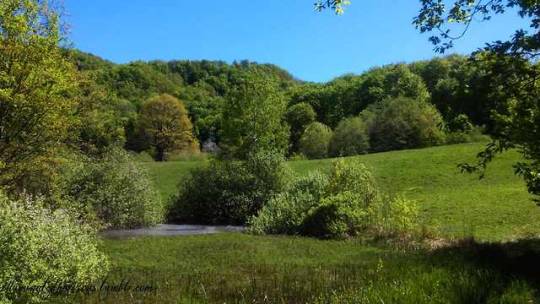
Srbija Gornja Trepca is a village near the City of Cacak in the Moravian district. The village is in the country, and wider, most famous by the spa of the same name, also known as Atomska Banja (Atomic spa), so, in 2011. the entire village officially got the status of the spa.
The Vujan Mountain (from the northwest side) and Bukovik (from the east) are connected by the slopes and hills, which surround the village from the north, west and east sides, while towards the south of Gornja Trepca it is open to the Cacak - Kraljevo basin. In the village, the slopes of the Vujan and Bukovik mountains are separated by a water course, which spring - Vilina voda (Fairy water) is located at the foot of the hill Cerje in the mountaineer’s hill of Gornja Trepca. The stream flows through the rocky gorge between the hills of Kos and Liplje at high speed, through the cascades, which is why it is called the Besni potok (Wild stream). After leaving the gorge, downstream of the thermal mineral springs, this stream is called the Banja (Spa) river, which flows south and into West Morava in the village of Mojsinje.
1 note
·
View note
Text
7 Most Endangered Heritage Sites
The list of the 7 Most Endangered monuments and heritage sites in Europe for 2023 has been announced by Europa Nostra, the European Voice of Civil Society Committed to Cultural and Natural Heritage, and the European Investment Bank (EIB) Institute.
vimeo
The 7 Most Endangered sites for 2023 are Kortrijk Railway Station in Belgium, Partisan Memorial Cemetery Mostar in Bosnia and Herzegovina, Tchakvinji Fortress Zugdidi in Georgia, Sisters’ House Ensemble (former Moravian settlement Kleinwelka) in Germany, Memento Park Budapest in Hungary, Cultural Landscape of Sveti Stefan Paštrovići in Montenegro and Watermills of Bistrica Petrovac na Mlavi in Serbia.

The Executive Vice-President of Europa Nostra, Guy Clausse, stated “By putting these heritage sites on the 2023 list of 7 Most Endangered, we wish to convey a message of hope, solidarity and support to the local communities and activists who are resolutely determined to save them. Together with our partners we will provide technical expertise, identify possible sources of funding and mobilise our wide network to support their cause and their efforts, which have now become also our cause and our shared responsibility. Let us use Europe’s cultural heritage as a vector for peace, social cohesion and sustainable development.”
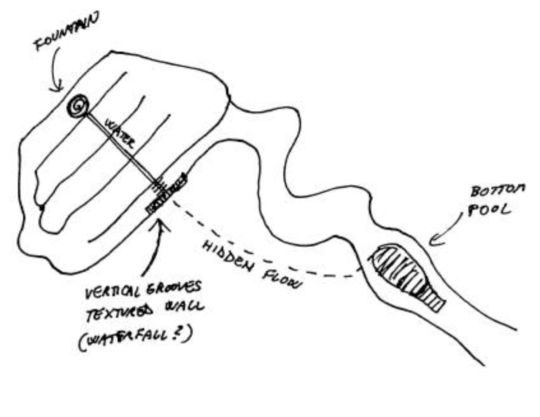
Bruno Rossignol, the Head of Programme for Climate and Heritage at the European Investment Bank Institute, added: “Cultural heritage is a key resource for shaping our European identity, without which economic growth is meaningless. This cohesive power is recognised by the EIB which takes heritage preservation into account when reviewing new investment projects or when lending for urban renewal projects, often with a heritage component. On the 10th anniversary of the programme, the sites selected today will once more testify to the cohesive power of cultural heritage and link with the Bank’s mission and activities.”

The Board of Europa Nostra selected the finalists from among the 11 monuments and heritage sites from eight countries previously shortlisted by the Advisory Panel of the 7 Most Endangered programme. The nominations were put forward by member organisations, associate organisations or individual members of Europa Nostra, as well as by members of the European Heritage Alliance.
The selection was made on the basis of the outstanding heritage significance and cultural value of each of the sites, as well as the serious danger that they are facing today. The level of engagement of local communities and the commitment of public and private stakeholders to saving these sites were considered crucial added values. Another selection criterion was the potential of these sites to act as a catalyst for sustainable socio-economic development as well as a tool for promoting peace and dialogue within their localities and wider regions.

Architectuul is glad to announce that also with our support for the Partisan Memorial Cemetery in Mostar won the attention of ten jury. In light of the promotion of the recent inclusion of the Partisan memorial cemetery in Mostar on the list of the seven most endangered monuments in Europe, Europa Nostra program 7ME 2023, on Sunday 23rd April 2023 starting at 19:00 at OKC ABrašević Mostar will be an opening of the exhibition "Architecture. Sculpture. Memory. Art of the Monuments of Yugoslavia 1945 – 1991."
The organizer of the promotion of the Exhibition in Mostar is Urban house IDEAA, DESSA Gallery and Architectuul. The exhibition will begin with a conversation with the curators of the exhibition Maja Ivanič (DESSA Gallery) and dr. Boštjan Bugarič (Architectuul).
***
Europa Nostra is the European voice of civil society committed to safeguarding and promoting cultural and natural heritage. It is a pan-European federation of heritage NGOs, founded in 1963 and supported by a wide network of public bodies, private companies and individuals, covering over 40 countries. It is recognised as the largest and the most representative heritage network in Europe, maintaining close relations with the European Union, the Council of Europe, UNESCO and other international bodies. Europa Nostra actively contributes to the definition and implementation of European strategies and policies related to heritage, through a participatory dialogue with European Institutions and the coordination of the European Heritage Alliance. Europa Nostra is among the official partners of the New European Bauhaus initiative developed by the European Commission, and is the Regional Co-Chair of the Climate Heritage Network for Europe and the Commonwealth of Independent States.
4 notes
·
View notes
Text
SO YOU’RE A CHRISTIAN? WHAT FLAVOR?
AN INCOMPLETE LIST OF MODERN CHRISTIAN SECTS AND CULTS:
CATHOLIC CHURCH
Latin Church
Catholic Charismatic Renewal
Blue Army of Our Lady of Fátima
Legion of Mary (active and auxiliary)
International Catholic Conference of Scouting
Cursillo
Worldwide Marriage Encounter
Marian Movement of Priests
Militia Immaculatae
International Alliance of Catholic Knights
Knights of Columbus
Schoenstatt Apostolic Movement
Nocturnal Adoration Societies
Neocatechumenal Way
Couples for Christ
Society of Saint Vincent de Paul
Secular Franciscan Order
Young Christian Workers (JOC)
School of the Cross
Focolare Movement
Christian Life Community
Opus Dei
Pax Romana
Community of Sant'Egidio
Communion and Liberation
Salesian Cooperators Association
Christian Life Movement
Regnum Christi
Our Lady's Rosary Makers
Personal Ordinariate for former Anglicans
Eastern Catholic Churches
Alexandrian Rite
Ethiopian Catholic Church
Coptic Catholic Church
Eritrean Catholic Church
Antiochene Rite
Maronite Catholic Church
Syro-Malankara Catholic Church
Syriac Catholic Church
Armenian Rite
Armenian Catholic Church
Byzantine Rite
Ukrainian Greek Catholic Church
Melkite Greek Catholic Church
Romanian Greek Catholic Church
Ruthenian Greek Catholic Church
Hungarian Greek Catholic Church
Slovak Greek Catholic Church
Italo-Albanian Catholic Church
Belarusian Greek Catholic Church
Byzantine Catholic Church of Croatia and Serbia
Georgian Byzantine Catholic Church
Albanian Greek Catholic Church
Bulgarian Greek Catholic Church
Greek Byzantine Catholic Church
Macedonian Greek Catholic Church
Russian Greek Catholic Church
Chaldean Rite
Syro-Malabar Catholic Church
Chaldean Catholic Church
Canonically irregular groups
Society of Saint Pius X
PROTESTANTISM
Baptist churches
Southern Baptist Convention
National Baptist Convention, USA, Inc
Nigerian Baptist Convention
National Missionary Baptist Convention of America
National Baptist Convention of America, Inc.
Baptist Union of Uganda
Baptist Community of Western Congo
Baptist General Convention of Texas
Baptist Convention of Tanzania
Brazilian Baptist Convention
Progressive National Baptist Convention
Council of Baptist Churches in Northeast India
Baptist Bible Fellowship International
American Baptist Churches USA
Lott Carey Foreign Mission Convention
Baptist Community of the Congo River
National Primitive Baptist Convention of the U.S.A.
Myanmar Baptist Convention
Cooperative Baptist Fellowship
Baptist General Association of Virginia
Baptist Convention of Kenya
Nagaland Baptist Church Council
Korea Baptist Convention
Samavesam of Telugu Baptist Churches
Orissa Evangelical Baptist Crusade
National Baptist Convention (Brazil)
Church of Christ in Congo–Baptist Community of Congo
Baptist Convention of Malawi
Garo Baptist Convention
Convention of Philippine Baptist Churches
Ghana Baptist Convention – 0.3[21]
Union of Baptist Churches in Rwanda
Conservative Baptist Association of America
National Association of Free Will Baptists
Convention of Visayas and Mindanao of Southern Baptist Churches
Manipur Baptist Convention
Baptist Community in Central Africa
Lutheranism
Evangelical Church in Germany
United Protestants i.e. Lutheran & Reformed
Lutherans
Reformed
Ethiopian Evangelical Church Mekane Yesus
Evangelical Lutheran Church in Tanzania
Church of Sweden
United Evangelical Lutheran Churches in India
Batak Christian Protestant Church
Church of Denmark
Evangelical Lutheran Church of Finland
Church of Norway
Evangelical Lutheran Church in America
Malagasy Lutheran Church
The Lutheran Church of Christ in Nigeria
Lutheran Church–Missouri Synod
Evangelical Lutheran Church of Papua New Guinea
Evangelical Church of the Lutheran Confession in Brazil
Evangelical Lutheran Church in Namibia
Evangelical Lutheran Church in Southern Africa
The Protestant Christian Church
The Indonesian Christian Church
Evangelical Lutheran Church in the Republic of Namibia
Wisconsin Evangelical Lutheran Synod
Evangelical Free Church of America
Lutheran Congregations in Mission for Christ
Evangelical Lutheran Church of Cameroon
Evangelical Church of the Augsburg Confession in Austria
Evangelical Lutheran Church in Zimbabwe
Evangelical Lutheran Church of Latvia
Christian Protestant Church in Indonesia
Church of Iceland
Simalungun Protestant Christian Church
Evangelical Lutheran Church of Brazil
Protestant Church of Augsburg Confession of Alsace and Lorraine
Evangelical Church of the Augsburg Confession in Slovakia
Evangelical-Lutheran Church in Hungary
Estonian Evangelical Lutheran Church
Methodism
United Methodist Church
African Methodist Episcopal Church
Church of the Nazarene
Methodist Church Nigeria
The Salvation Army
Methodist Church of Southern Africa
Korean Methodist Church
African Methodist Episcopal Zion Church
United Methodist Church of Ivory Coast
Free Methodist Church
Christian Methodist Episcopal Church
Methodist Church Ghana
Methodist Church in India
Methodist Church in Kenya
Wesleyan Church
Methodist Church of Great Britain
Methodist Church in Brazil
Calvinism
Reformed Presbyterian
Presbyterian Church of East Africa
Presbyterian Church of Nigeria
Presbyterian Church of Africa
Presbyterian Church in Korea (HapDong)
Presbyterian Church of Korea (TongHap)
National Presbyterian Church in Mexico
Church of Christ in Congo
Presbyterian Community of Congo
Presbyterian Church of Cameroon]
Presbyterian Church (USA)
Presbyterian Church of India
Church of Central Africa Presbyterian
Presbyterian Church of Brazil
Presbyterian Church in Sudan
Presbyterian Church in Cameroon
Presbyterian Church in Korea (HapDongBoSu II.)
Presbyterian Church in Korea (BaekSeok)
Evangelical Presbyterian Church, Ghana
United Church of Christ in the Philippines
Uniting Presbyterian Church in Southern Africa
United Church of Canada
Church of Scotland
Presbyterian Church in America
Presbyterian Church of Pakistan
Presbyterian Church in Korea (Koshin)
Korean Presbyterian Church
Presbyterian Church in Rwanda
Uniting Church in Australia
Presbyterian Church in Taiwan
Presbyterian Church in Ireland
Continental Reformed churches
Church of Jesus Christ in Madagascar
Protestant Church in Indonesia
United Church in Zambia
Evangelical Church of Cameroon
Swiss Reformed Church
Protestant Church in the Netherlands
Christian Evangelical Church in Timor
Dutch Reformed Church in South Africa (NGK)
Christian Evangelical Church in Minahasa
United Church in Papua New Guinea and the Solomon Islands
Protestant Church in Western Indonesia
Evangelical Christian Church in Tanah Papua
Protestant Church of Maluku
Reformed Church in Hungary
Reformed Church in Romania
Uniting Reformed Church in Southern Africa
Toraja Church
Reformed Church of France
Lesotho Evangelical Church
Evangelical Christian Church in Halmahera
Christian Church of Sumba
Karo Batak Protestant Church
Christian Reformed Church of Nigeria
Reformed Church in Zambia
Evangelical Reformed Church in Angola
Reformed Church in America
Christian Reformed Church in North America
Kalimantan Evangelical Church
Javanese Christian Church
Indonesia Christian Church
Church of Christ in the Sudan Among the Tiv
Church of Lippe
Evangelical Church of Congo
Christian Evangelical Church of Sangihe Talaud
Central Sulawesi Christian Church
Evangelical Reformed Church in Bavaria and Northwestern Germany
Congregationalism
United Church of Christ
Evangelical Congregational Church in Angola
United Congregational Church of Southern Africa
Anabaptism
Mennonites
Schwarzenau Brethren/German Baptists
Amish
Hutterites
Hussites
Moravians
Czechoslovak Hussite Church
Unity of the Brethren
Quakers (Religious Society of Friends)
Modern Protestantism
Pentecostalism
Assemblies of God
Apostolic Church
International Circle of Faith
Fangcheng Fellowship
China Gospel Fellowship
Church of God (Cleveland, Tennessee)
International Church of the Foursquare Gospel
Church of God in Christ
Jesus Is Lord Church Worldwide
International Pentecostal Holiness Church
United Pentecostal Church International
The Pentecostal Mission
Christian Congregation of Brazil
True Jesus Church
The Church of Pentecost
Universal Church of the Kingdom of God
Pentecostal Assemblies of the World
Apostolic Faith Mission of South Africa
Church of God of Prophecy
Association of Pentecostal Churches of Rwanda
God is Love Pentecostal Church
Nondenominational Evangelicalism
Calvary Chapel
Born Again Movement
Association of Vineyard Churches
Christian and Missionary Alliance
Church of God (Anderson, Indiana)
African Initiated Protestant Churches
Zion Christian Church
Eternal Sacred Order of Cherubim and Seraphim
Kimbanguist Church
Redeemed Christian Church of God
Church of the Lord (Aladura)
Council of African Instituted Churches
Church of Christ Light of the Holy Spirit
African Church of the Holy Spirit
African Israel Church Nineveh
Seventh-day Adventist Church
New Apostolic Church
Lord's Recovery (Watchman Nee)
Lord's Recovery (Witness Lee
Local churches or Church Assembly Hall
Eastern Lightning
The Shouters
Restoration Movement
Churches of Christ
Christian churches and churches of Christ
Christian Church (Disciples of Christ)
Community of Disciples of Christ in Congo
Plymouth Brethren
Anglicanism
Anglican Communion
Church of England
Church of Nigeria
Church of Uganda
Anglican Church of Kenya
Episcopal Church of South Sudan and Sudan
Church of South India
Anglican Church of Australia
Anglican Church of Southern Africa
Anglican Church of Tanzania
Episcopal Church in the United States
Anglican Church of Canada
Church of North India
Anglican Church of Rwanda
Church of the Province of Central Africa
Anglican Church of Burundi
Church in the Province of the West Indies
Anglican Church in Aotearoa, New Zealand and Polynesia
Church of the Province of the Indian Ocean
Church of Christ in Congo–Anglican Community of Congo
Church of Pakistan
Church of Ireland
Church of the Province of West Africa
Anglican Church of Melanesia
Episcopal Church in the Philippines
Continuing Anglican movement and independent churches
Traditional Anglican Communion
Anglican Church in North America
Reformed Evangelical Anglican Church of South Africa
Eastern Orthodox Church ( Non-Chalcedonian)
Autocephalous Churches
Russian Orthodox Church
Romanian Orthodox Church
Church of Greece
Serbian Orthodox Church
Bulgarian Orthodox Church
Georgian Orthodox Church
Greek Orthodox Church of Constantinople
Greek Orthodox Church of Antioch
Greek Orthodox Church of Alexandria
Orthodox Church in America
Polish Orthodox Church
Albanian Orthodox Church
Church of Cyprus
Greek Orthodox Church of Jerusalem
Czech and Slovak Orthodox Church
Autonomous churches
Ukrainian Orthodox Church (Moscow Patriarchate)
Moldovan Orthodox Church
Russian Orthodox Church Outside Russia
Metropolitan Church of Bessarabia
Orthodox Ohrid Archbishopric
Estonian Orthodox Church (Moscow Patriarchate)
Finnish Orthodox Church
Chinese Orthodox Church
Japanese Orthodox Church
Latvian Orthodox Church
Non-universally recognized churches
Ukrainian Orthodox Church (Kyiv Patriarchate)
Ukrainian Autocephalous Orthodox Church
Belarusian Autocephalous Orthodox Church
Macedonian Orthodox Church
Orthodox Church of Greece (Holy Synod in Resistance)
Old Calendarist Romanian Orthodox Church
Old Calendar Bulgarian Orthodox Church
Orthodox Church in Italy
Montenegrin Orthodox Church
Other separated Orthodox groups
Ukrainian Autocephalous Orthodox Church
Old Believers
Greek Old Calendarists
True Orthodox Church
Evangelical Orthodox Church
Oriental Orthodoxy
Autocephalous Churches
Ethiopian Orthodox Tewahedo Church
Coptic Orthodox Church of Alexandria
Armenian Apostolic Church
Mother See of Holy Etchmiadzin
Holy See of Cilicia
Armenian Patriarchate of Constantinople
Armenian Patriarchate of Jerusalem
Syriac Orthodox Church
Jacobite Syrian Christian Church
Eritrean Orthodox Tewahedo Church
Malankara Orthodox Syrian Church
Autonomous Churches
French Coptic Orthodox Church
Churches not in communion
Mar Thoma Syrian Church
Malabar Independent Syrian Church
British Orthodox Church
Restorationism and Nontrinitarianism
Latter Day Saint movement (Mormonism)
The Church of Jesus Christ of Latter-day Saints]
Community of Christ
Jehovah's Witnesses
Oneness Pentecostalism
United Pentecostal Church International
Pentecostal Assemblies of the World
Minor Denominations
Iglesia ni Cristo
La Luz del Mundo
Unitarian Universalism
Unitarian Universalist Association
(Unitarian Universalism developed out of Christian traditions but no longer identifies as a Christian denomination.)
Church of Christ, Scientist
Friends of Man
Christadelphians
Family International
Independent Catholicism
Philippine Independent Church
Chinese Patriotic Catholic Association
Brazilian Catholic Apostolic Church
Traditionalist Mexican-American Catholic Church
Old Catholic Church
Polish National Catholic Church
Apostolic Catholic Church
Palmarian Catholic Church
Minor Branches
Church of the East (Nestorianism)
Assyrian Church of the East
Ancient Church of the East
Messianic Judaism
And tell me again why yours is “THE ONE TRUE FAITH!”
Laz
25 notes
·
View notes
Photo




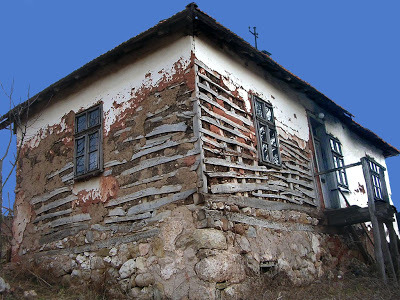

The Moravian House
In the area of the West Morava (Central and Eastern Serbia) it's more the Bondruka-type of house, usually two-room (living-space and sleeping-space) with tented roof covered with ceramic tiles. The walls are plastered and mostly white. Some have a stone socle or even a stone basement underneath. The Moravian House is widespread all over Serbia.
Source: http://sajkaca.blogspot.co.uk/2010/09/lesson-2-in-traditional-serbian-rural.html
75 notes
·
View notes
Photo

Repost from @meet.the.serbs using repost_now_app - Medieval town of Koznik is one of the few preserved Serbian medieval fortifications. Its remains date back to the late 14th century and are situated on the slopes of Mount Kopaonik, at 921 m.a.s.l. Koznik was first mentioned in the Charter of Serbian Prince Lazar in 1381, and traces of construction in the Moravian style indicate that it was built during the same period as a number of other Serbian fortifications (Kruševac, Prokuplje, Pirot). The fortress has an irregular shape that follows the configuration of the terrain, with the greatest length of 58 m and width of 44 m. Its walls are reinforced with 8 towers, and the Donjon Tower is situated on the highest point. Today it is partially preserved and is under the state protection. --------------- Средњевековни град Козник спада међу неколико најочуванијих српских средњевековних утврђења. Његови остаци потичу с краја 14. века, а налазе се на обронцима Копаоника, на узвишењу од 921 метар н.в. Козник се први пут помиње у Повељи кнеза Лазара из 1381. године, a трагови грађења у Моравском стилу указују да је подигнут у истом периоду као и низ других утврђења (Крушевац, Прокупље, Пирот). Утврђење је неправилног облика који прати конфигурацију терена, са највећом дужином од 58 м и ширином од 44 м. Његови бедеми су ојачани са 8 кула, а на највишој тачки смештена је Донжон кула. Данас је делимично конзервиран и налази се под заштитом државе. •••••••••••••••••••••••••••••••• Photo credits Aутор фотографије: ★ @87darko ★ •••••••••••••••••••••••••••••••• Location / Локација: Central Serbia / Централна Србија ••••••••••••••••••••••••••••••••• #Srbija #Србија #Сербия #Serbia #Srbi #Serbs #Срби #Europe #россия #tourism #meettheserbs #nationalgeographic #earthpix #drone #dronephotography #artofvisuals #royalsnappingartists #instatravel #landscape #adventure #travel #beautifuldestinations #travelphotography #naturelover #nature #summer #architecture #archdaily #kopaonik #koznik https://www.instagram.com/p/CSJPz1is1TX/?utm_medium=tumblr
#srbija#србија#сербия#serbia#srbi#serbs#срби#europe#россия#tourism#meettheserbs#nationalgeographic#earthpix#drone#dronephotography#artofvisuals#royalsnappingartists#instatravel#landscape#adventure#travel#beautifuldestinations#travelphotography#naturelover#nature#summer#architecture#archdaily#kopaonik#koznik
0 notes
Photo



Saints of the Day – 14 February – Sts Cyril (827-869) & Methodius (826-885) Bishops, Confessors, Theologians, Missionaries, Writers, Preachers, Patrons of Europe, Apostles to the Slavs. Sts Cyril & Methodius were two brothers who were Byzantine Christian theologians and Christian missionaries. Through their work they influenced the cultural development of all Slavs, for which they received the title “Apostles to the Slavs”. They are credited with devising the Glagolitic alphabet, the first alphabet used to transcribe Old Church Slavonic. After their deaths, their pupils continued their missionary work among other Slavs. In 1880, Pope Leo XIII introduced their feast into the calendar of the Roman Catholic Church. In 1980, St Pope John Paul II declared them co-patron saints of Europe, together with Benedict of Nursia.

St Cyril’s Patronages – against storms, ecumenism, Slavic peoples (given in 1863 by Pope Pius IX), unity of the Eastern and Western Churches, Bohemia, Bosnia, Bosnia-Herzegovina, Bulgaria, Carinthia, Austria, Carniola, Circassia, Croatia, Czech Republic, Czechoslovakia, Dacia, Dalmatia, Europe (given in 1980 by St Pope John Paul II), Khazaria, Krain, Krajna, Kranjska, Moravia, Pannonia, Russia, Silesia, Slovenia, Yugoslavia, Ljubljana, Slovenia, archdiocese of, Maribor, Slovenia, archdiocese of, Saints Cyril and Methodius of Toronto, Ontario, diocese of. St Methodius’s Patronages – against storms, ecumenism, Slavic peoples (given in 1863 by Pope Pius IX), unity of the Eastern and Western Churches, Bohemia, Bosnia, Bosnia-Herzegovina, Bulgaria, Carinthia, Austria, Carniola, Circassia, Croatia, Czech Republic, Czechoslovakia, Dacia, Dalmatia, Europe (given in 1980 by St Pope John Paul II), Khazaria, Krain, Krajna, Kranjska, Moravia, Pannonia, Russia, Silesia, Slovenia, Yugoslavia, Ljubljana, Slovenia, archdiocese of, Maribor, Slovenia, archdiocese of, Saints Cyril and Methodius of Toronto, Ontario, diocese of.
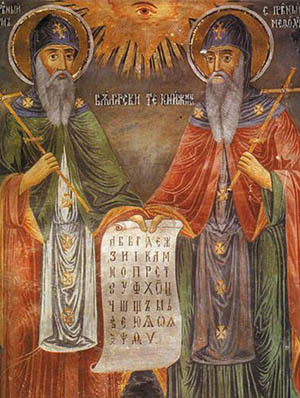
Methodius and Cyril (born Constantine) were born into a prominent Christian family in Thessalonica. As the area in which they were raised was a popular spot for Slavic people to settle in, traditions tells us that the holy brothers grew up familiar with the Slavic language (Slavonic). While we know their father was a prominent officer in the army, little is known of their young lives. History has recorded that Methodius, the elder brother, rose to the position of an important civil authority, who likely dealt in law and trade. His brother, Cyril, was trained as a scholar, professor and philosopher who gained renown in Constantinople.
After some years in public service, Methodius grew tired of worldly affairs and retired, seeking out solace and contemplation in a monastery. Eventually, Cyril joined him there, refusing a district to govern, preferring quiet devotion to the Lord. Together they lived in peace until the Byzantine emperor, having received a request for missionaries by the Moravian prince Rastislav, sent the brothers as missionaries to modern-day Ukraine. Being familiar with the language and well-acquainted with administration and politics, they were the perfect choice for such a mission. And given Rastislav’s desire for independence from Germany, Eastern missionaries (such as Methodius and Cyril) could help him gain independence over Church affairs.

Cyril and Methodius firmly believed that the Liturgy should be celebrated in the native language of the people, for greater inclusion in the Mass—a tradition which continues today. At that time, many were committed to only celebrating Mass in Greek or Latin, but these holy brothers dedicated themselves to proving otherwise. Prior to their departure for Moravia, they created a script for Slavonic (which had not previously existed). Known as Glagolithic, this written script is considered the precursor to Cyrillic (named after Saint Cyril). The creation of this script would allow the translation of Scripture and Liturgy into the language of the people.
Upon their arrival, Cyril immediately began translating the Liturgy into Slavonic. This created anxiety in the German priests, who saw the use of language as the next step to Slavic independence, and they actively worked against the translation. As neither Cyril nor Methodius was ordained a bishop, they travelled to Rome with their candidates for the priesthood to see the pope. After an audience, the pope approved the use of the Slavonic language in services, ordaining the local priests and securing the presence of Catholicism in the region.
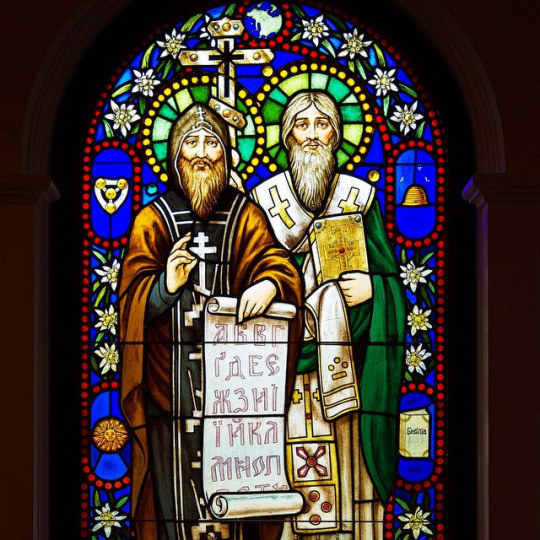
Sadly, Constantine never returned to Moravia. He entered the monastery, taking the name Cyril and not long after died. Methodius was stricken with grief and wished for nothing more than live the remainder of his days in the monastery but honoured a promise made to his brother and returned to finish their missionary work. Due to the political upheaval in Moravia, he was forbidden to return there. However, upon his ordination as bishop, he was invited to modern-day Serbia and Croatia, where he assumed the bishopric of Sirmium. There he continued to say Mass and administer baptisms in the native, Slavonic tongue.
Again, falling victim to the anxiety of the German priests and bishops, Saint Methodius was imprisoned and only released following Moravian independence from German and intervention from the pope. Again, Methodius traveled to Rome, meeting with the Pope, and explaining how important it was to celebrate the Liturgy in the tongue people understood. Instead of condemning him, as the German bishops had hoped, the pope gave him permission to use Slavonic in the Mass, in Scripture reading and in the office. He also made him head of the hierarchy in Moravia.
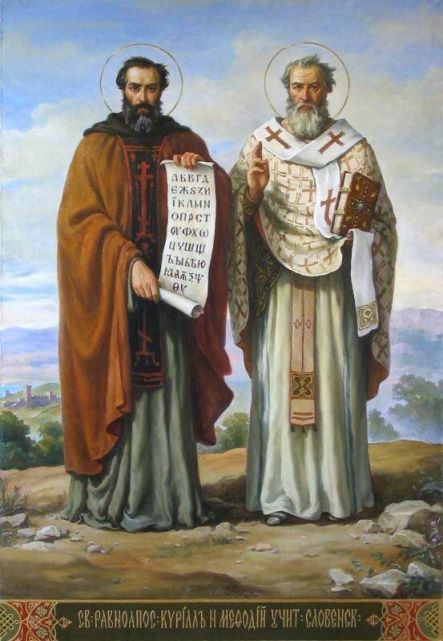
Saint Methodius, despite constant criticism and backlash, never stopped translating. It is said that he had translated the Bible and the works of the Church Fathers into Slavonic before his death.
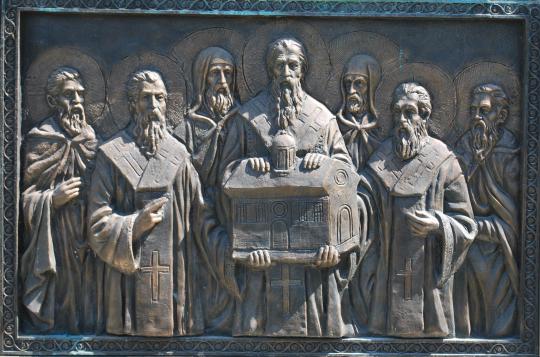
Memorial Monument to Sts Cyril & Methodius in Skopje

(via AnaStpaul – Breathing Catholic)
41 notes
·
View notes